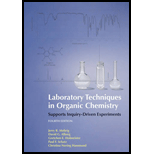
(a)
Interpretation:
Among acetylsalicylic acid, acetic acid, phosphoric acid, and acid anhydride, that are hazardous to breathe dust/vapor/fumes should be explained.
Concept introduction:
Material Safety DataSheet is a document that contains details on the potential health effects of exposure to the chemicals. It also provides guidance for safe procedures to handle chemical products. The hazard evaluations on the use and storage of chemicals and the safety measure taken if accidents occur.
(b)
Interpretation:
Among acetylsalicylic acid, acetic acid, phosphoric acid, and acid anhydride the compounds that are most likely to be inhaled accidentally on the basis of their boiling point should be determined.
Concept introduction:
The temperature at that the vapor pressure of a liquid is equal to the atmospheric pressure is termed as the boiling point of that liquid. Lower the atmospheric pressure above a liquid, the lower is the temperature to boil the liquid. The temperature at that a substance changes state from its solid-state to liquid state is known as its melting point. The solid and liquid phase of a substance exists in equilibrium at the melting point.
(c)
Interpretation:
Among acetylsalicylic acid, acetic acid, phosphoric acid, and acid anhydride, the compounds that are most dangerous to inhale based on the GHS hazard information should be explained.
Concept introduction:
Chemicals used in the laboratories affect our lives. The widespread utilization of chemicals has caused the development of sector-specific regulations. Therefore, readily available information about hazardous properties of chemicals and recommended control measures make the use and disposal of chemicals to be managed safely. Globally Harmonized System of Classification and Labelling of Chemicals explains and classifies hazards related to a chemical product.
explains and classifies hazards related to a chemical product.
(d)
Interpretation:
Among acetylsalicylic acid, acetic acid, phosphoric acid, and acid anhydride the compounds that are used to be handled in fume hood should be determined.
Concept introduction:
A fume hood is an enclosed device except for the necessary exhaust purposes that are on three sides, top and bottom. It is designed to draw air inward by means of mechanical ventilation and also used to control the exposure to hazardous substances.
Trending nowThis is a popular solution!

Chapter 1 Solutions
Laboratory Techniques in Organic Chemistry
- Using wedge-and-dash bonds, modify the bonds on the chiral carbon in the molecule below so the molecule has R stereochemical configuration. NH H Br X टेarrow_forwardProvide photos of models of the following molecules. (Include a key for identification of the atoms) 1,2-dichloropropane 2,3,3-trimethylhexane 2-bromo-3-methybutanearrow_forwardPlease draw the structure in the box that is consistent with all the spectral data and alphabetically label all of the equivalent protons in the structure (Ha, Hb, Hc....) in order to assign all the proton NMR peaks. The integrations are computer generated and approximate the number of equivalent protons. Molecular formula: C13H1802 14 13 12 11 10 11 (ppm) Structure with assigned H peaks 2.08 3.13arrow_forward
- A 0.10 M solution of acetic acid (CH3COOH, Ka = 1.8 x 10^-5) is titrated with a 0.0250 M solution of magnesium hydroxide (Mg(OH)2). If 10.0 mL of the acid solution is titrated with 10.0 mL of the base solution, what is the pH of the resulting solution?arrow_forwardFirefly luciferin exhibits three rings. Identify which of the rings are aromatic. Identify which lone pairs are involved in establishing aromaticity. The lone pairs are labeled A-D below.arrow_forwardA 0.10 M solution of acetic acid (CH3COOH, Ka = 1.8 x 10^-5) is titrated with a 0.0250 M solution of magnesium hydroxide (Mg(OH)2). If 10.0 mL of the acid solution is titrated with 10.0 mL of the base solution, what is the pH of the resulting solution?arrow_forward
- Given a complex reaction with rate equation v = k1[A] + k2[A]2, what is the overall reaction order?arrow_forwardPlease draw the structure in the box that is consistent with all the spectral data and alphabetically label all of the equivalent protons in the structure (Ha, Hb, Hc....) in order to assign all the proton NMR peaks. The integrations are computer generated and approximate the number of equivalent protons. Molecular formula: C13H1802 14 13 12 11 10 11 (ppm) Structure with assigned H peaks 2.08 3.13arrow_forwardCHEMICAL KINETICS. One of the approximation methods for solving the rate equation is the steady-state approximation method. Explain what it consists of.arrow_forward
- CHEMICAL KINETICS. One of the approximation methods for solving the rate equation is the limiting or determining step approximation method. Explain what it consists of.arrow_forwardCHEMICAL KINETICS. Indicate the approximation methods for solving the rate equation.arrow_forwardTRANSMITTANCE เบบ Please identify the one structure below that is consistent with the 'H NMR and IR spectra shown and draw its complete structure in the box below with the protons alphabetically labeled as shown in the NMR spectrum and label the IR bands, including sp³C-H and sp2C-H stretch, indicated by the arrows. D 4000 OH LOH H₂C CH3 OH H₂C OCH3 CH3 OH 3000 2000 1500 HAVENUMBERI-11 1000 LOCH3 Draw your structure below and label its equivalent protons according to the peak labeling that is used in the NMR spectrum in order to assign the peaks. Integrals indicate number of equivalent protons. Splitting patterns are: s=singlet, d=doublet, m-multiplet 8 3Hb s m 1Hd s 3Hf m 2Hcd 2Had 1He 鄙视 m 7 7 6 5 4 3 22 500 T 1 0arrow_forward
 Chemistry for Today: General, Organic, and Bioche...ChemistryISBN:9781305960060Author:Spencer L. Seager, Michael R. Slabaugh, Maren S. HansenPublisher:Cengage Learning
Chemistry for Today: General, Organic, and Bioche...ChemistryISBN:9781305960060Author:Spencer L. Seager, Michael R. Slabaugh, Maren S. HansenPublisher:Cengage Learning
